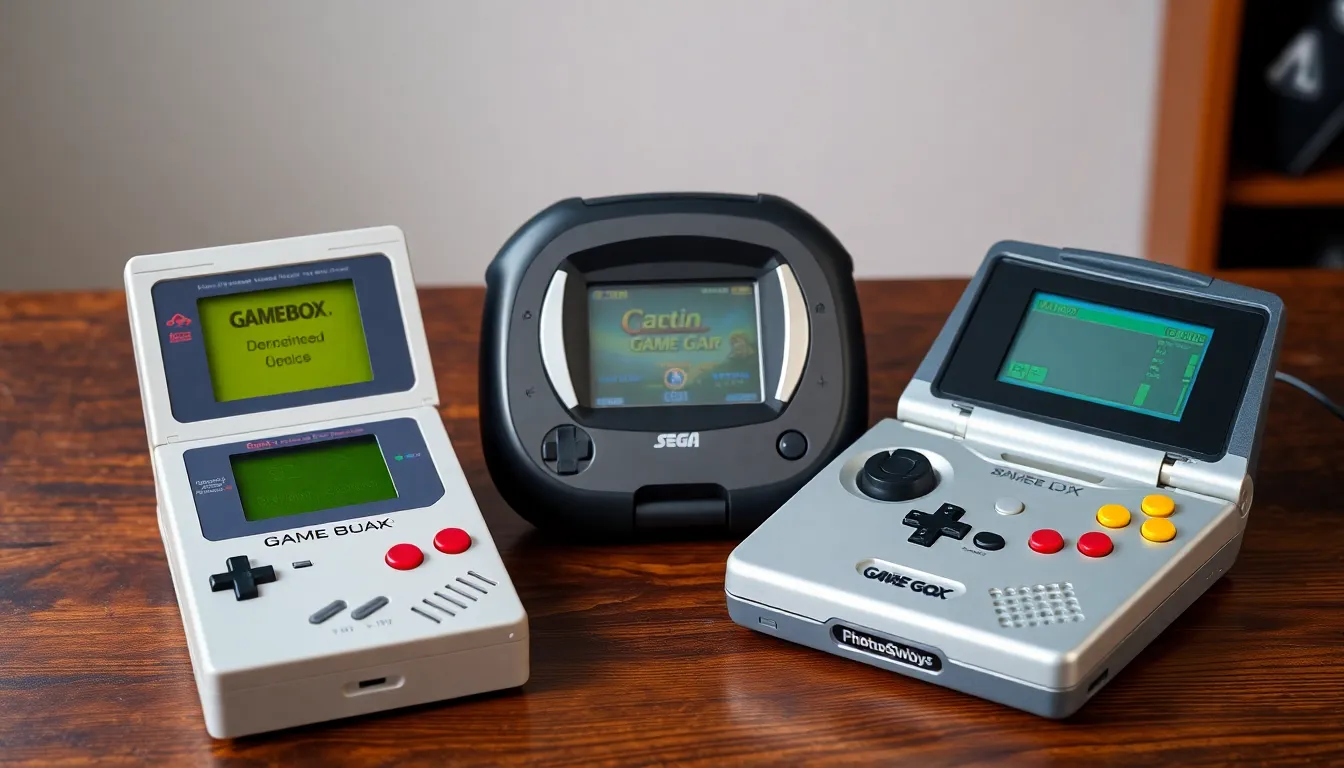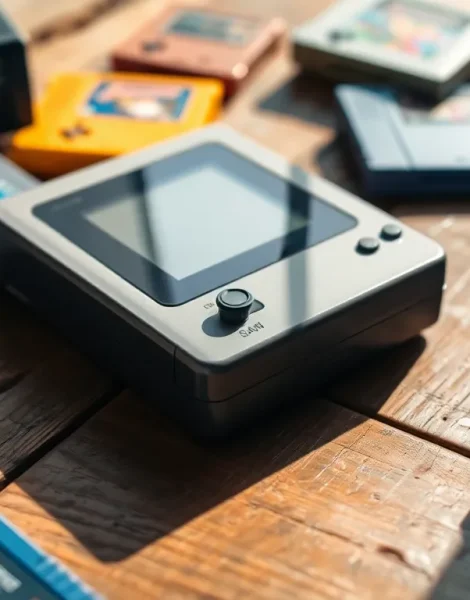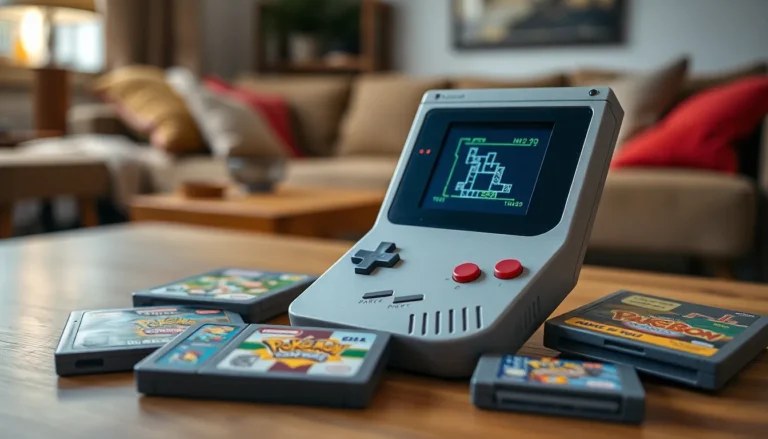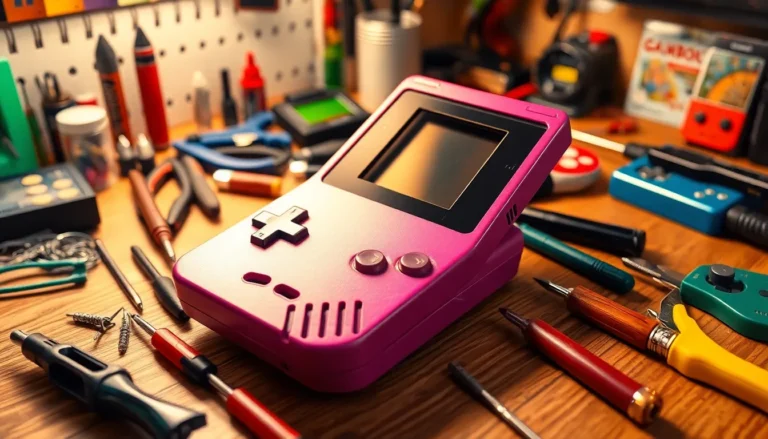In a world where gaming has evolved into sprawling open worlds and lifelike graphics, it’s easy to forget the charm of the original handheld consoles. These pocket-sized powerhouses brought gaming to the masses, allowing players to enjoy their favorite titles on the go. Imagine squeezing hours of adventure into your backpack, all while avoiding the awkwardness of eye contact on public transport.
From the iconic Game Boy to the quirky Neo Geo Pocket, these devices not only entertained but also sparked a revolution in gaming culture. They were the ultimate companions for long car rides and boring family gatherings. So, grab your favorite snack and get ready to take a nostalgic trip down memory lane, where pixelated heroes and 8-bit soundtracks reign supreme. The story of original handheld consoles is one of innovation, creativity, and a dash of fun that still resonates today.
Table of Contents
ToggleThe Evolution of Original Handheld Consoles
Original handheld consoles saw significant advancements starting with the late 1970s. Devices like the Milton Bradley Microvision marked the entry point, showcasing interchangeable cartridges. In the 1980s, Nintendo’s Game Boy revolutionized the market. It featured a robust library and a long battery life, establishing the blueprint for future devices.
Various consoles followed, each introducing unique features. Sega’s Game Gear offered color graphics, providing a different gaming experience that contrasted with the Game Boy’s monochrome display. The Neo Geo Pocket presented another compelling alternative, recognized for its responsive controls and compact design.
As technology progressed, innovations continued. The rise of backlit screens and improved battery performance enhanced gameplay quality. Sony’s PlayStation Portable debuted in 2004, pushing boundaries with multimedia capabilities, further diversifying the market.
Competitors like the Nintendo DS and its dual screens brought new gameplay mechanics, capturing a wider audience. Each generation aimed to improve user experience, offering more engaging gaming possibilities.
In recent years, nostalgia reignited interest in retro gaming. Many players rediscovered the charm of original handheld consoles, fostering a renewed appreciation for their cultural significance. The impact of these devices remains profound, as they laid the groundwork for modern portable gaming experiences.
Handheld consoles fostered social interaction and gaming communities. They connected players through multiplayer options, enhancing the shared gaming experience. This rich history illustrates the dynamic evolution of handheld gaming, showcasing how original consoles laid the foundation for today’s technology.
Iconic Original Handheld Consoles

Handheld consoles revolutionized gaming, offering portability and social interaction. Several iconic devices shaped the landscape of portable gaming.
Nintendo Game Boy
Launched in 1989, the Nintendo Game Boy marked a major milestone in handheld gaming. It featured interchangeable cartridges, enabling players to access a vast library of games. With its iconic green screen, it captivated audiences worldwide, selling over 118 million units. The combination of long battery life and simplicity made it accessible to gamers of all ages. Titles such as Tetris and Pokémon started their journey here, creating a cultural phenomenon that persists today.
Sega Game Gear
The Sega Game Gear debuted in 1990 as a response to Nintendo’s dominance. It boasted a full-color backlit screen along with impressive graphics for its time. Game Gear’s library included popular titles like Sonic the Hedgehog and Streets of Rage, appealing to a broad audience. Although it offered an enhanced gaming experience, it struggled with battery life, often lasting only three to five hours. Despite this, the console gained a loyal fan base and established Sega’s commitment to handheld gaming.
Atari Lynx
Atari introduced the Lynx in 1989, showcasing innovative features that set it apart from competitors. The system offered two screen orientations and superior graphics for its era. It included a robust game library with titles like California Games and Gauntlet: The Third Encounter. Although it received praise for its technical capabilities, its market presence was limited due to aggressive competition. The Lynx exemplified Atari’s creativity and laid groundwork for future handheld innovations.
Features and Innovations
Original handheld consoles introduced several groundbreaking features and innovations that transformed gaming. These advancements delivered unique experiences, leading to a strong impact on the gaming industry.
Screen Technology
Screen technology evolved significantly across original handheld consoles. The Game Boy featured a reflective monochrome screen, allowing play in various lighting conditions. In contrast, the Sega Game Gear showcased a vibrant color display, which brought games to life. Atari’s Lynx pushed boundaries further with the ability to switch between horizontal and vertical orientations, enhancing gameplay versatility. As consoles evolved, innovations like backlighting emerged, offering clearer visibility in dim environments. The Nintendo DS took it a step further by incorporating dual screens, enabling innovative gameplay mechanics and increased interactivity.
Battery Life
Battery life played a critical role in the success of original handheld consoles. The Game Boy gained recognition for its long-lasting batteries, often lasting up to 30 hours on just four AA batteries. Sega’s Game Gear, though featuring superior graphics, offered a much shorter battery lifespan of about 3 to 5 hours, which turned many players away. Innovations came with the introduction of rechargeable batteries in devices like the Sony PlayStation Portable; this change allowed for more prolonged gaming sessions without frequent replacements. Ultimately, these advancements in battery technology greatly influenced consumers’ choices and shaped future designs in handheld consoles.
Impact on Gaming Culture
Original handheld consoles significantly influenced gaming culture, sparking nostalgia and fostering community engagement. Their portability allowed players to enjoy gaming anytime and anywhere.
Nostalgia and Collectibility
Retro handheld consoles evoke fond memories for many gamers. Iconic devices like the Game Boy foster collector communities, where enthusiasts seek out rare editions and accessories. Collectors often share tips and stories, connecting through shared experiences. The nostalgic appeal drives up prices on auction sites, demonstrating the lasting impact of these consoles. Limited runs, such as the Neo Geo Pocket Color, highlight the desire for unique additions to collections. Enthusiasts frequently celebrate anniversaries of beloved consoles, reinforcing their cultural significance.
Influence on Modern Handheld Devices
Modern handheld devices owe much to their original counterparts. Innovations introduced by early models paved the way for features in contemporary devices. The dual-screen concept from the Nintendo DS inspired subsequent designs, allowing for interactive gameplay experiences. Current handhelds often incorporate advanced technologies like high-resolution displays and touch functionality, which enhance user engagement. Various features found in devices today draw from the foundational principles established by earlier consoles. Gamers who appreciate these advancements recognize the lasting influence of original handheld consoles on industry development and user expectations.
Original handheld consoles left an indelible mark on gaming history. Their innovative designs and unique features paved the way for the portable gaming experiences enjoyed today. These devices not only provided entertainment but also fostered social connections and community engagement among gamers.
As nostalgia for retro gaming continues to grow, these consoles remain cherished artifacts of a transformative era. Their influence can still be seen in modern handheld devices that prioritize user experience and portability. The legacy of original handheld consoles is a testament to their creativity and the joy they brought to millions.









